1912 No.1 MkIII Enfield Rifle (Battle Damaged)
(Manufactured by BSA)

(Click PIC to Enlarge)
Here is my blown up No1 Mk3 dated early --it is a 1912 mfg unit by BSA. The rifle is all correct still retaining it's volley sights and serialled to the receiver --barrel, bolt etc.
The bore is mirror, it gauges very tight as if it was never used a lot.
For those reasons I believe the soldier that carried it was killed early on in World War 1.
The man I bought it from said that it came from his wife's father who was in the military and that the rifle hung in an officers mess for decades and decades. Apparently the soldier was a very popular fellow in the regiment and when he was killed the rifle itself was retrieved and hidden away from the unit armourers.
The rifle could be shot by replacing the following.
a) Foreend and handguards--riddled by shrapnel and blast effect
b) triggerguard -hit and bent by shrapnel
c) magazine-- riddled by lots of shrapnel
Other than that it shows some surface rust here and there I keep it well oiled now and just cannot alter it to shoot it.
Finishing the story I was told about it's history.
The soldier was killed by some blast whether by shell or landmine I would not know a shell makes the most sense I guess.
At any rate the soldier was highly respected so the unit hid the rifle, all throughout WW1 and brought it back to Canada. I believe he said his wifes father has in the common wealth --South Africa army, Aussie or British, I cannot remember I will have to ask again.
But they saved it from the armourers and ended returning it to their officers mess in the city where they came from.
There it sat for decades ending up in the back closet of the father and upon his death they found it laying there.
BSA 1912 No1 Mk3
All numbers matching
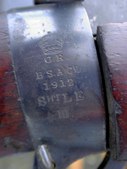
(Click PIC to Enlarge)
The rifle has been cleaned up and preserved since these photos taken at the time I bought it for $100.00 Canadian about seven years or so ago. Could not help myself. One fellow said --THATS NOT WORTH ONE HUNDRED DOLLARS IT'S "JUNK". Yes "but junk with some serious history" that being--a piece of history that a soldier used to go to war to fight for us all and gave his life, the ultimate sacrifice.
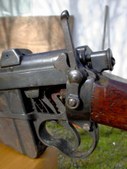
(Click PIC to Enlarge)
When I hold this rifle in my hands as one would walk a path with the rifle across your front from left to right you can see where the soldiers left leg protected some of the foreend between the magazine and the front sight--look for that in the next picture. Here is the blast effect on the magazine area and trigger guard. And one now can imagine some of the rifles that arrived at Unit Armourers for a field rebuild.
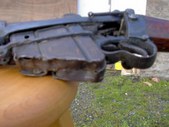
(Click PIC to Enlarge)
Here is the foreend and you can see where his left leg protected the foreend as the blast came up from below the soldier.
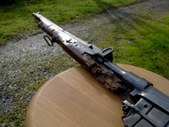 (Click PIC to Enlarge)
(Click PIC to Enlarge)
Another pic from the front angle.
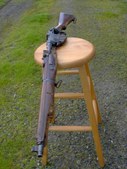
(Click PIC to Enlarge)
Here is the trigger guard that was hit dead on by shrapnel or a bullet? The Magazine is riddled by shrapnel through and through.
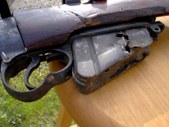
(Click PIC to Enlarge)
The nose cap is missing the foreend and wobbles around on the barrel.

(Click PIC to Enlarge)
Missing wood here.
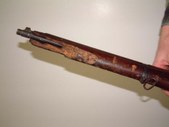
(Click PIC to Enlarge)
I have always assumed that the --WA-- is western Australia that is well documented and accepted as fact.
The --CNF-- is however a mystery.
One Australian theorized it was -Commonwealth Naval Force?
I don't know about that but it sounds possible but I have never ever been able to prove it.
One thing we know is that the rifle was obviously in a battle somewhere.
It sure points out the work unit armourers would have been exposed to in the field when every rifle that was damaged was required back at the front.
This one as I posted was hidden by the unit a brought back to their country that could well have been Australia.
I will have to ask the nationality of Ken's wife's father and when he emigrated to Canada.
Now in the first POST I posted that Ken thought the rifle was damaged in the first World War. That is what he said, but he also said that no one really knew as the father never specifically said WW1 it could have been WW2 but if that was the case it would probably not have the volley sights, mag cuttoff and an original barrel serial numbered to the receiver dated 1912 as is the receiver.
But back to the unit markings.
I know this
a) WA is western Australia
b) the brass unit disc -RM- is Royal Marines
c) the -CNF- maybe commonwealth Naval Forces.
Another Enfield mystery.

(Click PIC to Enlarge)
(Manufactured by BSA)
(Click PIC to Enlarge)
Here is my blown up No1 Mk3 dated early --it is a 1912 mfg unit by BSA. The rifle is all correct still retaining it's volley sights and serialled to the receiver --barrel, bolt etc.
The bore is mirror, it gauges very tight as if it was never used a lot.
For those reasons I believe the soldier that carried it was killed early on in World War 1.
The man I bought it from said that it came from his wife's father who was in the military and that the rifle hung in an officers mess for decades and decades. Apparently the soldier was a very popular fellow in the regiment and when he was killed the rifle itself was retrieved and hidden away from the unit armourers.
The rifle could be shot by replacing the following.
a) Foreend and handguards--riddled by shrapnel and blast effect
b) triggerguard -hit and bent by shrapnel
c) magazine-- riddled by lots of shrapnel
Other than that it shows some surface rust here and there I keep it well oiled now and just cannot alter it to shoot it.
Finishing the story I was told about it's history.
The soldier was killed by some blast whether by shell or landmine I would not know a shell makes the most sense I guess.
At any rate the soldier was highly respected so the unit hid the rifle, all throughout WW1 and brought it back to Canada. I believe he said his wifes father has in the common wealth --South Africa army, Aussie or British, I cannot remember I will have to ask again.
But they saved it from the armourers and ended returning it to their officers mess in the city where they came from.
There it sat for decades ending up in the back closet of the father and upon his death they found it laying there.
BSA 1912 No1 Mk3
All numbers matching
(Click PIC to Enlarge)
The rifle has been cleaned up and preserved since these photos taken at the time I bought it for $100.00 Canadian about seven years or so ago. Could not help myself. One fellow said --THATS NOT WORTH ONE HUNDRED DOLLARS IT'S "JUNK". Yes "but junk with some serious history" that being--a piece of history that a soldier used to go to war to fight for us all and gave his life, the ultimate sacrifice.
(Click PIC to Enlarge)
When I hold this rifle in my hands as one would walk a path with the rifle across your front from left to right you can see where the soldiers left leg protected some of the foreend between the magazine and the front sight--look for that in the next picture. Here is the blast effect on the magazine area and trigger guard. And one now can imagine some of the rifles that arrived at Unit Armourers for a field rebuild.
(Click PIC to Enlarge)
Here is the foreend and you can see where his left leg protected the foreend as the blast came up from below the soldier.
Another pic from the front angle.
(Click PIC to Enlarge)
Here is the trigger guard that was hit dead on by shrapnel or a bullet? The Magazine is riddled by shrapnel through and through.
(Click PIC to Enlarge)
The nose cap is missing the foreend and wobbles around on the barrel.
(Click PIC to Enlarge)
Missing wood here.
(Click PIC to Enlarge)
I have always assumed that the --WA-- is western Australia that is well documented and accepted as fact.
The --CNF-- is however a mystery.
One Australian theorized it was -Commonwealth Naval Force?
I don't know about that but it sounds possible but I have never ever been able to prove it.
One thing we know is that the rifle was obviously in a battle somewhere.
It sure points out the work unit armourers would have been exposed to in the field when every rifle that was damaged was required back at the front.
This one as I posted was hidden by the unit a brought back to their country that could well have been Australia.
I will have to ask the nationality of Ken's wife's father and when he emigrated to Canada.
Now in the first POST I posted that Ken thought the rifle was damaged in the first World War. That is what he said, but he also said that no one really knew as the father never specifically said WW1 it could have been WW2 but if that was the case it would probably not have the volley sights, mag cuttoff and an original barrel serial numbered to the receiver dated 1912 as is the receiver.
But back to the unit markings.
I know this
a) WA is western Australia
b) the brass unit disc -RM- is Royal Marines
c) the -CNF- maybe commonwealth Naval Forces.
Another Enfield mystery.
(Click PIC to Enlarge)
Collector's Comments and Feedback:
1. Terry is close in his guess as to the meaning of the markings found on the butt of this rifle. According to Skennerton's book "The Broad Arrow", the markings are Australian and mean:
WA = West Australia
C.N.F. = Cadet Naval Forces
.......... (Feedback by "Badger")
2. I had asked about the markings...
RM = Royal Marines
CNF -- Possibly Cadet Naval Forces but I have never been convinced
WA- = Western Australia.
I have now found official Australian use of the CNF as CommonWealth Naval Forces this is noted to have been instituted in 1901.
It is on page 11 at the bottom on this Australian Navy Letter (click here)
I think we all should be notifying the web pages that have Lee Enfield Markings pages to add this to their official government markings.
.......... (Feedback by "terryinvictoria")









 Reply
Reply

 Countries
Countries Categories
Categories